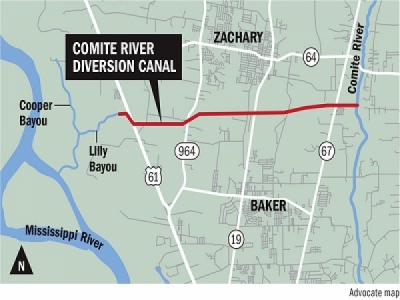
Posted on September 21, 2017
By Bryn Stole And Steve Hardy, The Advocate
A meeting between top brass at the U.S. Army Corps of Engineers and Gov. John Bel Edwards Monday on the long-stalled Comite River Diversion flood-control project left the governor feeling encouraged — but left open key questions over project funding.
The Corps’ commanding officer, Lt. Gen. Todd T. Semonite, called the Comite River project “critically important” and agreed in principle to a construction scheme that would build the diversion canal in sections over several years, Edwards said Monday afternoon, just after the meeting. Edwards also said the Corps of Engineers called the project a viable one based on their current cost-benefit analysis.
“The flooding we had last August, I think, has raised this project in their consciousness, so there’s more of a commitment to actually getting it done,” Edwards said.
But Semonite hasn’t committed any specific money from his agency budget to get the project built, the governor said.
Funding has remained the primary rub for the project ever since it was first authorized 25 years ago. First pushed in earnest after the destructive 1983 floods in Baton Rouge, the canal’s design would redirect water from the Comite River to the Mississippi during periods of high water.
The Corps of Engineers also decisively stated that federal law prohibits Louisiana from using any FEMA hazard mitigation funding to pay for Corps-authorized projects like the Comite River Diversion Canal. That assertion echoes similar responses from FEMA and the federal Department of Housing and Urban Development and appears to shut the door on using existing federal disaster money from the 2016 floods to get the long-delayed project moving.
The governor, however, said there’s some hope that likely congressional aid packages for areas ravaged by Hurricanes Harvey and Irma might also include funds for Louisiana designated for disaster-related infrastructure projects. The state has requested about $600 million in such funding, some of which would cover the Comite Diversion project, but it wasn’t included in earlier congressional appropriations for the 2016 Louisiana floods.
The state Legislature set aside $87 million for the project in its latest construction spending bill, a figure that would cover the state’s proposed share of the project. But the Corps, which is slated to contribute the largest chunk toward the project’s price tag, hasn’t committed money to it.
Edwards on Monday said he’s optimistic that a section-by-section approach to the 12-mile diversion canal might provide a way forward.
“There was an agreement in principle today to try to move where you’re funding a new segment every two years,” Edwards said, “which is a heck of an improvement over where we have been.”
Residents of the watershed area in parts of East Baton Rouge, Livingston and Ascension parishes approved a tax to help fund the project 17 years ago. A total of about $117 million — about $78 million from the Corps and a bit under $40 million split between the state and the Comite River Basin Commission — has been spent on the project so far, used for land purchases, studies and the construction of a flood-control structure at Lily Bayou.
But frustration over the stalled project has mounted, especially after last year’s devastating floods.
“What happened last August could recur, and we’re in no better position than we were 14 or 15 months ago,” said Bob Burns, who lives in the watershed area.
“We want to protect ourselves, but we also want to protect the future generations so they don’t have to live in the same fear that we have.”
Since the flood, Burns, a 41-year resident of Central, has been prodding his neighbors to learn about the diversion canal and contact political leaders to advocate for its construction. He hosted another informational meeting Monday night.
“The primary thing is the commitment of the money necessary to complete the canal … and not dig it piecemeal,” Burns said.
State Rep. Valarie Hodges, R-Denham Springs, has said the state should start paying for its share of the canal work to demonstrate it has skin in the game.
“It’s like a stand-off,” she said of the relationship between the state and federal governments.
Louisiana has to pay for work such as relocating utility lines and building a bridge on Louisiana 61 for the canal to flow under. Hodges believes that investing in those projects will show the Corps that the state is committed.
“This project has got to get done,” she remarked.
State officials, however, have been hesitant to pour the money into those projects without firm commitments from the federal government to fund their share of the project.
Hurricanes Harvey and Irma “were a wake-up call” to federal leaders about the dangers threatening the Gulf Coast, Hodges said.
“We actually have a governor who’s going to push this along with all the legislators. … It wasn’t just Republicans who flooded,” she continued.
State Sen. Regina Barrow, D-Baton Rouge, said the diversion canal appears to be gaining momentum and said it’s a good sign that the governor is taking meetings in Washington about the project.
“It’s a bipartisan issue. … We owe the people (to finish the work,)” she said.
She hopes Congress will allocate money in its next budget or as part of its Hurricane Irma and Harvey relief packages.
Source: The Advocate





